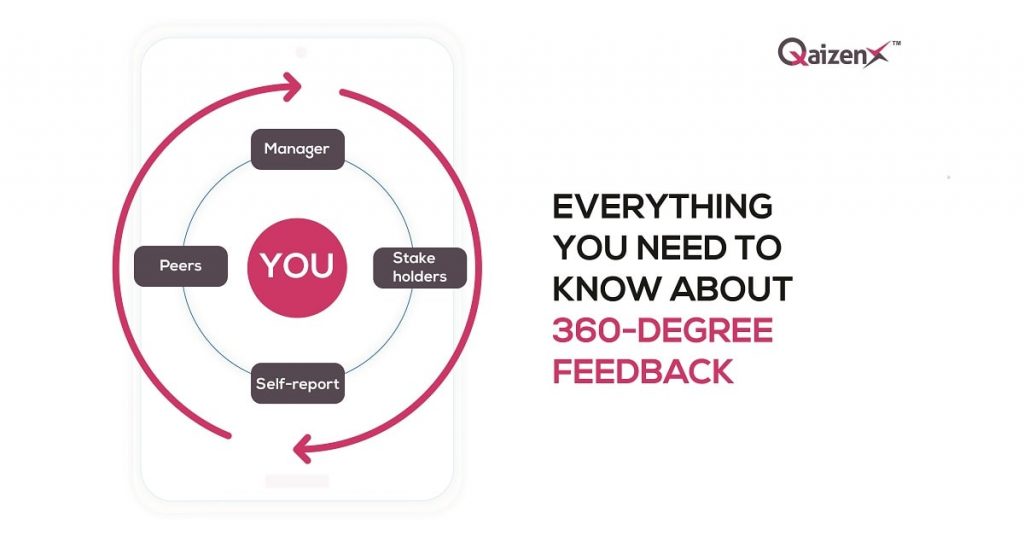Everything you Need to Know About 360-Degree Feedback

Companies that succeed strive to evaluate and guide their employees toward continuous improvement but a standard performance review system is often found inadequate. Companies are increasingly using 360-degree feedback as part of their review process, but some are finding that it’s not going as smoothly and easily as they hoped.
Multi-rater feedback processes can be sometimes difficult for organizations to introduce and implement. Nevertheless, 360-degree feedback can be effectively introduced and maximized if the right steps are taken. Evolving performance feedback techniques raise hackles in a big way, especially when they may affect how compensation is determined.
Employees benefit from feedback to improve because it helps them identify their strengths and weaknesses. Then they can improve themselves to become a better version of themselves.
Let’s start with comprehending what 360-degree feedback is all about.
What is 360-degree feedback?
360-degree feedback is a feedback system that allows employees to receive anonymous comments, concerns, and ratings on qualities from their colleagues, seniors, subordinates, stakeholders, etc,
It’s utilized generally as a leadership qualities improvement method since it gives information about a person’s work capabilities, conduct, and working links. Likewise, it is mainly used for people higher up in the organization’s progressive system, such as managers.
Positive aspects of 360° feedback
An effective 360-degree assessment can provide various benefits for individuals, their teams, and organizations:
Important improvement instrument:
The 360-degree framework shows the contrasts between how individuals see themselves and how others see them. This builds their mindfulness, which implies that they are more aware of their character, qualities, shortcoming, convictions, inspirations, etc. With this information, they can change their conduct and distinguish their preparation needs. Thus, that employee or manager can be more potent in their job and for the job they might be focusing on.
Different sources:
An assessment of individuals has been added to the feedback, so the data is believed to be more substantial and objective than input from. Additionally, the feedback must be acknowledged whether different people “concurred” with the responses.
Inspiration:
Knowing various people gave similar feedback gives the individual the drive to create. They get the motivation to change their shortcomings. Here are simple and effective ideas to motivate employees.
Organization abilities:
The organization’s key competencies are made up for the individual and the respondents. During the study, the respondents will address questions that help them remember what practices and qualities are essential to the organization.
Customer care:
Customer care can improve if customers and users write the survey. Because the information helps in improving the overall customer experience management.
Technique over results:
The 360 feedback system surveys are a strategy rather than the outcome. It’s more essential to accomplish something the correct way regardless of whether it produces the right result – nothing is ever sure. So, by zeroing in on the strategy, you do your best to get the favored outcome.
Enormous groups or independent specialists:
A survey of this kind is essential in organizations where the individual can work autonomously or with a few teams. This is because their supervisors may not be aware of all the details.
Further develops correspondence:
It increases communication among the team members because that individual sees how others see them, thus improving their relationship.
Focuses on individual’s conduct:
It assists individuals with seeing what their conduct means for themselves, their specialty, and the organization. This is very helpful for reducing struggle.
Vocation advancement:
The organization benefits from this input, further developing professional improvement arranging and execution. This likewise advances the organization’s affirmation of employee development, which helps in employee retention and increases employee engagement.
Challenges while taking 360° feedback and how to overcome it
If a 360-degree feedback system is executed ineffectively, this can make doubt, struggle, and low inspiration among the team members:
Clashing input:
Feedback can be clashing, and it is impossible to be sure which feedback is more precise. It can also impact workplace mental health if the process goes wrong. That’s why you should use trustworthy feedback software like QaizenX.
Only Focusing on negatives:
Organizations, in some cases, tragically rebate qualities and zero in totally on shortcomings. Assuming each of the negatives was recorded in a steady progression would deter the employee – they may either shut down or generally doubt the input. Your employees should be dealing with their shortcomings and taking benefit of their natural abilities.
Significance of the pioneer:
If the organization’s management accepts that this feedback isn’t significant or they don’t contribute, then it’s impossible that other employees will treat it in a proper way. When the senior management or bosses trust it’s worthiness, their convictions will work down the progressive system to convince every other person.
Less useful for small organizations:
360-degree feedback can be less viable as fewer sources and decreased objectivity.
Precision:
How much time an individual has known that individual influences the exactness of the feedback given. People who have known each other for under one year are less likely to provide exact information.
Pre-planned feedback:
Getting a precise result is impossible if the feedback is not pre-planned and employees have no idea about the process
No subsequent meet-ups:
An absence of subsequent meet-ups can make the survey useless because employees may not be adhering to their improvement plans. Subsequent meetings are supposed to be done quarterly for a considerable length of time with the overview being re-regulated every six months in a year.
Lacking secrecy:
Truancy of namelessness can wreck the entire cycle. A high level of secrecy is necessary or the respondents will not be honest. Likewise, outer mentors can be recruited to help employees through their subsequent meet-ups as staff will probably be more open to talking with outside sources than HR.
Execution surveys:
Some organizations use this 360-degree feedback system for execution audits. And it has been much of the time proposed that this needs legitimacy:
- Employees may not be prepared to assess others’ presentations.
- Respondents can control this system.
- The probability of control increments assuming these surveys are utilized for business choices for example, pay and advancements.
- Trust at work diminishes.
- Workplace wellness can decrease if things go wrong, and people can ruin their relationships. Negative feedback can harm employees’ sanity as well.
360-degree feedback has numerous shortcomings, yet they are primarily avoidable.
On the off chance that successful preparation has been given and there is a reasonable arrangement of how the 360-degree feedback will be utilized. These major issues will vanish. Consequently, enabling an organization with an anonymous, solid, and robust method for self-reflection.
Your organization must go for 360-degree feedback with proper goals, awareness, and planning. It surely helps in every way to the employee and the organization both.
If you’d like, QaizenX has an efficient 360-degree feedback system for your organization. You can schedule a demo and see for yourself. Request a Demo Now!
Recent Posts
- How People Analytics Can Utilize Data to Drive Business Results
- The Role of AI in Enhancing Employee Feedback Systems
- How Purpose-Built AI Can Help You Build A Great Customer Experience
- Why is Customer Sentiment Analysis Crucial to Your Business?
- Customer Experience Statistics You Need To Know for 2025 | CX Statistics 2024



